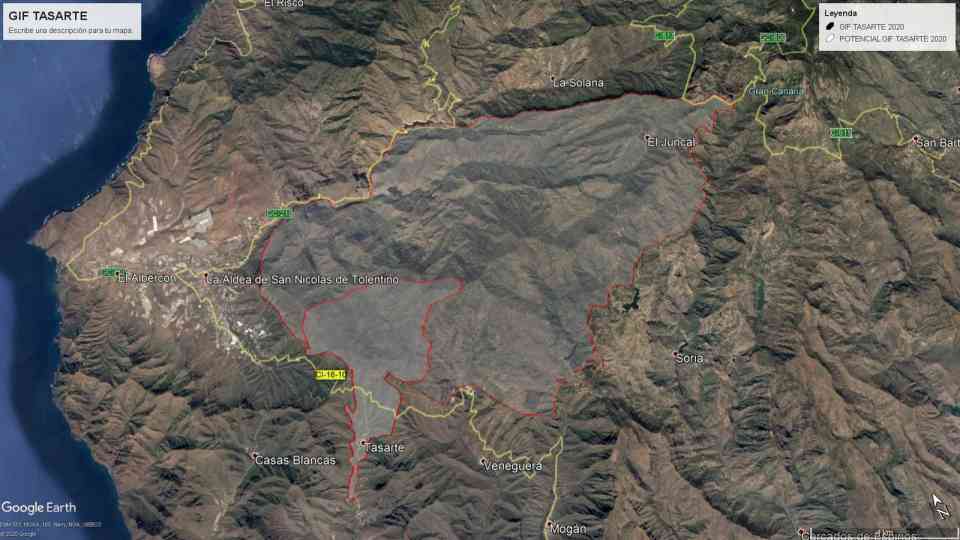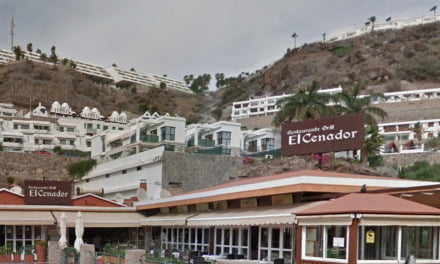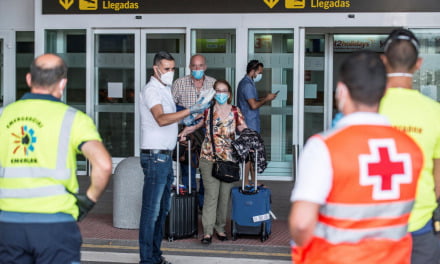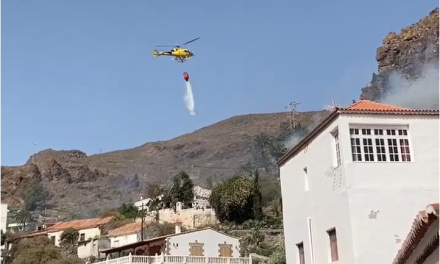 The Gran Canaria fire that broke out on Saturday (hashtagged #IFTasarte by official sources for Incendio Forestal Tasarte) has so far affected more than 1,000 hectares of the Inagua natural park, which has the potential to transfer the blaze across the inland sections of Mogán municipality and towards the summits at the centre of the island. The areas affected at the moment have been primarily scrublands and so far the fire has not been reported to have entered the pine forests
The Gran Canaria fire that broke out on Saturday (hashtagged #IFTasarte by official sources for Incendio Forestal Tasarte) has so far affected more than 1,000 hectares of the Inagua natural park, which has the potential to transfer the blaze across the inland sections of Mogán municipality and towards the summits at the centre of the island. The areas affected at the moment have been primarily scrublands and so far the fire has not been reported to have entered the pine forestsReports this morning from the Cabildo de Gran Canaria, governing island council, at a press conference, say that this Monday the teams are working intensely on the flank of the forested area known as Pajonales. All troops are in this area, since controlling it directly effects the progression of the fire.
 This flank has no forest trails, so the action of air crews is essential. However, the weather conditions have not allowed them to be fully activated this morning, beyond a helicopter that could only work for two hours. Adverse weather has even prevented some of the units that had arrived in Gran Canaria from being able to land. The air units are not expected to be able to operate normally for the rest of the day on Monday.
This flank has no forest trails, so the action of air crews is essential. However, the weather conditions have not allowed them to be fully activated this morning, beyond a helicopter that could only work for two hours. Adverse weather has even prevented some of the units that had arrived in Gran Canaria from being able to land. The air units are not expected to be able to operate normally for the rest of the day on Monday.
Throughout the night the upper area of Tasarte, El Llano de Las Brujas and the Aula de la Naturaleza were brought somewhat under control, while in the east, the fire was heading towards Los Riscos, where it should foreseeably die out. The inland flank has been heading in the direction of Tejeda where it could reach the areas burned last summer, so on that basis it “generates less concern,” according to reports from news agency Europa Press.
During the morning the people evacuated from their homes in the village of Tasartico were allowed to return and the Cabildo also reversed the evacuationsof Tocodomán and El Hoyo, near La Aldea de San Nicolas on the west coast. There were still elements of risk to consider, such as loose ground areas or the potential for landslides and other objects that could be dangerous, which made it impossible to definitively return any earlier. The western GC-200 road has been open since this morning. The GC-605 remains closed for operational reasons, since this route is being used by the personnel in the work of extinguishing the blaze. High winds and low rainfall are not helping. The president of the Cabildo, Antonio Morales, has stated that the weather situation is one of the determining factors in the evolution of the fire, also affected by the wild terrain of the area, with great shear slopes, which limit the abilities of any aerial means, which for now are not useable at all.
 At least 300 people have been affected by the fires. Who are receiving help including counselling and psychological attention. As for affected homes, the official number is still just four, all of them in Tasarte, with the damage being evaluated. The number of affected homes is directly related to the level of emergency, explained the president of the Cabildo Antonio Morales, who added that it is not necessary to raise the emergency level at this time because there are no more homes threatened and there are no difference as to how the fire is now being handled.
At least 300 people have been affected by the fires. Who are receiving help including counselling and psychological attention. As for affected homes, the official number is still just four, all of them in Tasarte, with the damage being evaluated. The number of affected homes is directly related to the level of emergency, explained the president of the Cabildo Antonio Morales, who added that it is not necessary to raise the emergency level at this time because there are no more homes threatened and there are no difference as to how the fire is now being handled.
He also added that the contact between administrations to coordinate troops is total and constant. In the area troops from the various firefighting installations are working, including: Braves, Dams Emergency Consortium of Gran Canaria, Military Emergency Unit, Firemen of Maspalomas, Firefighters of Las Palmas de Gran Canaria, Guardia Civil, Policia Canarias, Local Police and Civil Protection units.
The latest news is that air crews have been allowed to return to the action with the Cabildo de Gran Canaria tweeting that:
“The #GES helicopter operational once again in the #IFTasarte Inagua envelope.
Two seaplanes arrive tonight and will join in the morning.
The weather continues to prevent the transfer of helicopters from La Gomera and El Hierro
We insist, there are no threatened populations”
El helicóptero del #GES vuelve a operar en el #IFTasarte sobre Inagua
Los dos hidroaviones llegan esta noche y se incorporan por la mañana
El clima sigue impidiendo el traslado de los helicópteros de La Gomera y El Hierro
Insistimos, no hay poblaciones amenazadas
— Cabildo Gran Canaria (@GranCanariaCab) February 24, 2020














